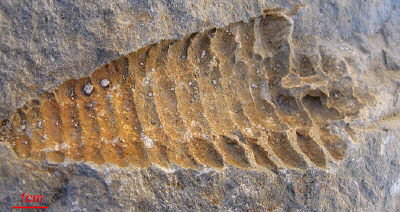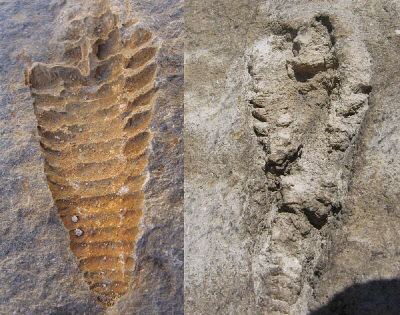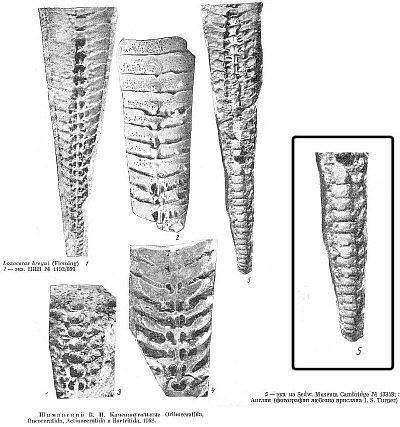Mystery fossil Carboniferous fossils of Russia
Click on pictures to Magnify
Discussion
I'm pretty sure it is an orthocone nautaloid. I've
seen a lot of similar
fossils (albeit Silurian) where the original organism is replaced with an
iron-based mineral. When exposed to the elements, the fossil is softer than
the surrounding limestone matrix and weathers much more quickly. It is also
more porous, which could account for the bumps. Look at the right edge of
the photo, and you can see the remains of the siphuncle running down the
center of the cone.
_______________________
looks like a trilobite got up, after it was knocked
down?
_______________________
I agree- it could be a cast of a dia- or flexicalymene
trilo. Looks like lobes in there.
_______________________
Neither of which are Pennsylvanian fossils, and where
is the tail? Yes, lobes
are present, which shows a tapering thorax. However, it could still be an
arthropod of some kind.
A fossil recently turned up here in a coal formation; looks an awful like
a
trilobite also, but it has no thorax, but is one coherent critter. We are
still
trying to identify it also. I have pictures should anyone want to take a stab
at it.
_______________________
Can you find out what the dimensions are on the scale
at the bottom of the
photo? Are the long marks equal to 1 cm or 1 inch?
Answer: 1 CM
_______________________
This looks very much like a trilobite to me. Going
left to right, the first 3 cm appear
to be fused just as the segments would be in a trilobite pygidium. From there
on, the
orientation of the individual segments suggests flexibility as in the thorax
of a trilobite.
There are definitely 3 lobes with the axial lobe in the center and pleural
lobes top and
bottom. The right side suggests enrollment into the matrix, but this could
also just be
what is left of a partial. I haven’t seen a partial “taper off”
like that. They usually break
off at a segment unless predation is involved but that is usually limited
to one side.
I don’t believe this can be a nautiloid because
of the way the segments are formed.
In a nautiloid, the segments would be continuous (top to bottom in this case)
and
more or less concentric on the central axis whether the geometry was linear
or spiral.
These segments show what I take to be the pleural portions properly offset
(to the
left in this case) from the axial portion.
I will leave the diagnosis of species to the experts,
but I would start looking in
the trilobite clades.
_______________________
Persuasive argument. Especially if the surface is
covered with bumps as described,
then it is most likely a trilobite.
I wish a little more matrix had been removed around
the edges to reveal if
she is wearing a frilly skirt or not.
Based on the drawings in Moore et a., it might be
a Kaskia, which was a
Mississippian trilobite that enrolled.
_______________________
My Kaskias look nothing like this fossil.
_______________________
I've never seen a Kaskia in person. Although Moore's
line drawings are
usually pretty accurate, I'm sure you're right on this one.
It was the only Carboniferous trilobite I could find
that doesn't have a
wide, fan-shaped pygidium or a lot of spines.
_______________________
I should have elaborated more; the enter lobe is
too wide and flattened.
The compression could come from fossilization, but I don't think so. The
center lobe segments are straight, only curved on the side lobes. This is
the cast of the specimen, it would be nice to see it in three dimensions.
I blew it up 400% to see it better, the very front
segment is bowed
inward and split by something; a stubby spine perhaps? It appears to have
more segments that go into the end of the picture frame. It would be nice
to see beyond the end of the frame. Are there more faint segments, as it
appears to start widening again. We need more pictures, one is not enough
to make an ID on an unknown, unless it rings a bell and jumps out at some
one on the list. I keep wanting to put my curser on the green unmarked ruler,
and advancing the picture. I would like to send you the picture of our unknown,
if you don't mind. When you look at it, it says trilobite, but when you start
looking further, you begin to notice what isn't there.
_______________________
OK, you wore me down, I'll give you a w.a.g. at it...
I see more mollusk than
arthropod. You may be looking at the internal mold of a high-spiraled snail.
The broken area on the far right looks like the columella and the parallel
"lobes"
look like whorl cavities.
_______________________
The fossil is not likely to be a trilobite, as there
is usually a disparity in the number
of pygidial segments in the axial and pleural lobes----far more segments in
the axial lobe
than in the pleural lobes (e.g., Ditomopyge has about a 14:9 ratio and Anisopyge
has
about a 28:10 axial:pleural ratio.
A possibility for this fossil is a bactritoid as on the right side, there
appears to be a trace
of a siphuncle. I have found some examples of bactritoids in the Pennsylvanian
of Nebraska
that are crushed in a similar manner to the fossil Barry illustrated.
_______________________
I'm glad I was not the only person to call it a ceph
at first glance. After
reading some of the other members' comments I'm still not sure, but I've
seen Silurian cephs that weather in a similar manner. I'm sure the new
photos will clarify things more.
_______________________
Just added a new page to the Paleolist photo album
Mystery fossil (Russia)
Here you will see some pictures from Alexander's archive
along with an archive of comments we have received
so far. (1CM scale is on the 1st picture)
Alexander will retrieve the fossil from storage and take more pictures.
Barry
_______________________
The illustrations of Loxoceras nautiloids do not help.
Photos 1, 3, 4 and 5 show cross-sections of a fossil.
The mystery
fossil is not a cross-section; it is a mold of the surface of a
fossil.
Go-Back Text
Menu or Thumb
Menu
Home
Page
Photo
Album search engine
search the Photo Album or the Web


